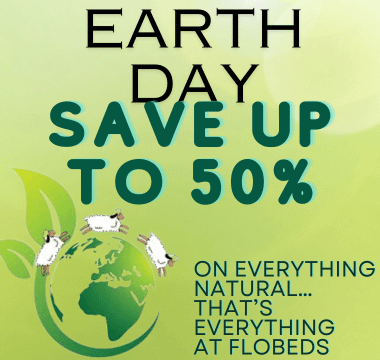Mt. Shasta WoolThe Woolgatherer’s Story:I began my involment with sheep and wool in western Montana. It was there I met one of my mentors, Mr. Jack Knox, a Scottish immigrant expert in sheep and in training sheep dogs. Jack is famous in both Scotland and the US as a “big hat” competitor in sheep dog competition. A national champion. Anyway, he got me started in this adventure by sorting me out with my first sheep dog. I still rely on him for advice in both raising sheep and training border collies. I bought his wool this year as a component of the blend of fleeces I use in my batting. |
|
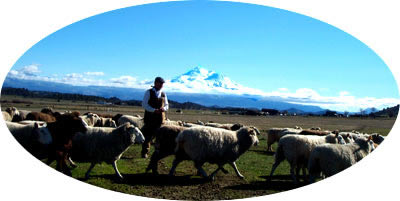 Woolgatherer Patrick with flock and Mt. Shasta in background |
|
|
After I left Montana and returned to California, I ran a few sheep as a hobby and to keep my hand in as a novice sheep dog handler and trainer. But I quickly began to notice the qualities of the wool that the sheep I raised provided. I was lucky enough to have purchased a flock of corriedale ewes as well as another group of cheviot ewes. I started to read up about fleece and the differing fiber characteristics that various sheep breeds offer. I scoured (washed)my first fleeces myself, learning just what makes up a good scouring job…water temperature, amount of surfactant (detergent), number of rinses, how to restore ph balance in scoured fleece. My first fleeces went to a custom carding mill to be made into both yarn and batting. The results were amazing, such beautiful yarn and resilient batting, I was hooked and wanted to do more with wool, but selling wool and yarn on a hobby basis yields almost nothing other than pride in quality of product (not that that isn’t a reward of its own!). I also wanted more land so that I could raise a larger flock of sheep. The ranch I have now is the outgrowth of both the desire to do more with wool and to keep a larger flock of sheep. |
|
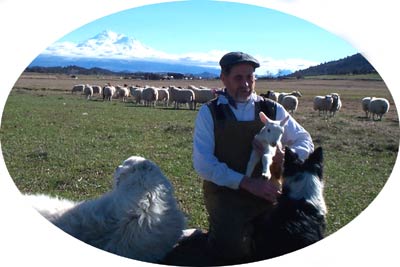 Patrick with sheepdogs large and small, lamb in arms |
|
|
As I grew as a sheep rancher I faced the sorrowful proposition that the wool market in the US could not compete with foreign wool, the prices paid for domestic wool was at a bottom, and many ranchers had stopped paying attention to the quality of the fleece that they produced. I got a lead to a small bedding maker who was looking for a quality fleece to be made in to batting. One thing led to another. I began a relationship with the bedding maker wherein I would source fleece for their use. The idea was that I would purchase the fleece, arrange for it to be scoured and carded into batting. I soon ran into a cost problem that was insurmountable. During my investigations into the world of wool processing I became aware of a mill that was being shut down by its corporate owners. The entire plant was being put up for auction. I made some calls and found that I could offer a pre-auction bid for select parts of the mill. I began to entertain the idea of purchasing my own carding line and batting production equipment. To that end I hired a mill consultant from Prince Edward Island, Canada to develop a business plan for me. I hired a millwright based in Texas to act as an advisor in analysing the mill that I would bid on. I made an offer on the mill that was being shut down. My bid was the highest entered and I was given very favorable terms resulting in my being able to visit the mill with my consultant and, basically, being able to cherry pick all ancillary equipment and parts consistent with long-term operation of a woolen carding operation. When I tell other millwrights, and mill owners the story of just how extensive a selection I was given in choosing machines and parts the reaction is of surprise that I was given such incredible value for my investment. Such is the luck of the innocent, I suppose. |
|
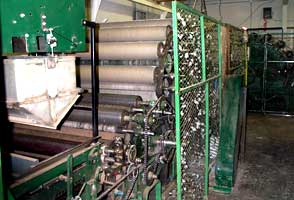 Wool Picker |
 Wool Carder |
|
Coincident with arranging the purchase and tear down of an existing plant, I began a search in earnest of wool types and breed characteristics in terms of fiber behavior. I became a fanatic, I called wool experts all over the place. I went to wool graders and buttonholed them at wool competitions. I took notes, asked questions over and over again. I collected samples at fleece shows. I arranged an extended visit to Pendleton Woolen Mills in Oregon/Washington, and there I was taken under the wing of their wool buyer, Mr. David Taft (now retired). He sat me down during a long lunch and gave me an compressed overview of fleece types, problems that wool buyers face with wool growers, geographic differences in wool quality, and then lent me some of the texts he had worked with during his own education in the craft. As I progressed, I began to make up sample blends of wool on a cottage carder that I purchased. I called wool growers and asked them to sent me samples of their fleece. I scoured that fleece and then blended them in various ratios. Some fleece I found to be unusable in the kind of batt that I wanted to produce. I was looking for a combination of things: Resilience and loft, softness to touch, cleanliness of the fleece when it is shorn (absence of dung…i.e., no belly wool, no hind quarter wool, and low vegetal matter retained in the fleece. I pay a hefty premium for good wool, for instance last year’s commoddity medium grade wool sold for an average of .38 cents LB whereas I paid .60 – 65 cents LB assuring that what I purchased was far cleaner than what other buyers were able to obtain. I also looked at the anount of “whiteness” after scouring various breeds showed, and, very importantly, durability over time in use. I knew that those were the qualities that bedding makers would want. I made 20 experimental blends of batting, and I selected within those samples a range of characteristics that would work. I then began to source that wool. I started finding out about sheep ranchers in the Pacific Northwest using as one of my sources a shearing contractor in central Oregon. |
|
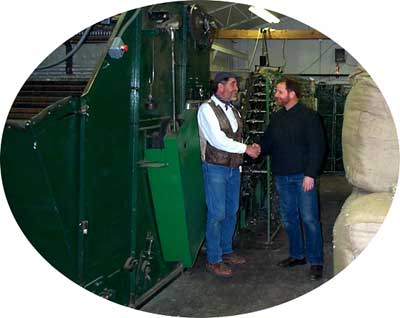 Dave and Patrick Agree to Put Pure Shasta Wool in Every FloBed |
|
|
As you know, I visit each wool grower that I purchase from. I can tell almost immediately upon arriving at each ranch just what kind of operation I am dealing with. Relative order about the ranch is a quick determination. I ask to look at their flock and can tell quickly what health condition the ewes are in, for healthy ewes = quality fleece. I look at the pasturage and can make a quick assessment of what kind of vegetal matter is likely to be in the fleece. Weedy pastures mean high stems of plant material, which, when they seed out will cause seed heads to become entangled in the fleece. I ask what kind of winter feeding practice is used. Last year I refrained from buying fleece from an organic grower because of his feeding manner, he threw alfalfa over the ewes backs from the bed of a pick-up truck assuring that there would be a heavy vegie load in the fleece. I wish he wouldn’t do that because his fleece is ideal in my blend for making batting. I tend to favor growers who are “green” in their land use practices and don’t overgraze or use herbicides. All of this is time consuming but is not really reflected in my wool prices to you. It’s just the way I like to run my business. Well, I don’t know if I have helped you with this rambling narrative. I think I’ve touched the high points, though, but if there are more specific questions you want me to respond to let me know. As a parting shot I’ll reiterate a quote from one grower I buy from: “You (Woolgatherer Ranch) are making a big difference in a small way.” He was referring to the top price I pay for wool that is treated right thereby encouraging growers to pay attention to their fleece. (Patrick Holland died in June of 2004. That year he wrote: “I’ve kicked a hole in heaven. We’ll miss you Patrick.)
|
|
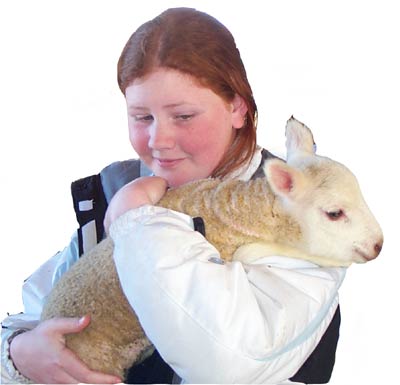 Bryna Holds a Wee Babe |
|

